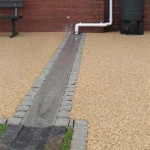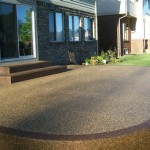How To Lay Patio Bricks Directly On Dirt Successfully
Creating a patio provides an outdoor living space, enhances property value, and expands usability of a yard. While various patio construction methods exist, laying patio bricks directly on dirt, without a concrete base, offers a more affordable and less complex approach. This method, however, requires careful preparation and execution to ensure a long-lasting and aesthetically pleasing result. This guide outlines the necessary steps to successfully lay patio bricks directly on dirt.
The primary benefit of laying patio bricks directly on dirt stems from its simplicity. The elimination of a concrete base significantly reduces material costs and labor time. This method is particularly suitable for smaller patios or areas where heavy loads are not anticipated. It is a viable option for homeowners seeking a do-it-yourself project that can be completed over a weekend. However, it is crucial to acknowledge that this type of patio might not be as durable as one built on a concrete foundation and might require more maintenance over time.
Understanding Soil Conditions and Drainage
The success of a patio laid directly on dirt hinges on the soil's composition and drainage capabilities. Soil that retains excessive moisture, such as clay, can lead to instability and brick shifting. Conversely, excessively sandy soil might not provide sufficient support. The ideal soil composition should be well-draining and compactable. Assessing the existing soil conditions is the first critical step.
A simple percolation test can determine the soil's drainage rate. Dig a hole approximately 12 inches deep and 12 inches wide. Fill the hole with water and allow it to drain completely. Refill the hole and measure the water level. Monitor the water level drop over the next hour. A drainage rate of approximately one inch per hour is considered ideal. If the drainage is significantly slower, soil amendments may be necessary.
Soil amendments involve adding materials to improve the soil's drainage and stability. For clay soil, incorporating coarse sand, gravel, or compost can enhance drainage. For sandy soil, adding organic matter, such as peat moss or compost, can improve water retention and compaction. The amendment should be thoroughly mixed into the topsoil to a depth of at least six inches.
Proper grading is also crucial for drainage. The patio surface should slope slightly away from the house to prevent water from pooling and potentially damaging the foundation. A slope of approximately one inch per eight feet is generally recommended. This slope will allow rainwater to naturally drain away from the structure.
Preparing the Base Layer
After evaluating and amending the soil, the next step involves preparing the base layer. This layer provides a stable and level surface for the bricks. The base typically consists of compacted gravel or crushed stone. The depth of the base layer depends on the anticipated use of the patio and the soil conditions. A minimum depth of four inches is recommended for light foot traffic, while a deeper base of six to eight inches is advisable for areas with heavier use or poor soil conditions.
Excavation is necessary to create space for the base layer. The area designated for the patio should be excavated to the required depth, taking into account the thickness of the bricks and the base layer. The edges of the excavated area should be clearly defined and straight.
Once the excavation is complete, a landscape fabric should be laid across the bottom of the excavated area. This fabric acts as a barrier, preventing weeds from growing up through the patio and hindering the base material from mixing with the underlying soil. The fabric should extend slightly beyond the edges of the excavated area and can be trimmed later.
The gravel or crushed stone should be spread evenly across the landscape fabric. A rake can be used to distribute the material and ensure a consistent depth. Compaction is essential for creating a stable base. A plate compactor or a hand tamper can be used to compact the gravel or crushed stone. Several passes with the compactor are recommended to achieve optimal compaction. The base should be level and free of any significant depressions or irregularities.
Following the compaction of the gravel or crushed stone, a layer of leveling sand is applied. This layer provides a smooth and even surface for laying the bricks. The sand should be a fine, sharp sand specifically designed for paving. Avoid using play sand, as it is too fine and does not compact well.
The leveling sand should be spread evenly over the compacted gravel or crushed stone to a depth of approximately one inch. A screed board, a long, straight piece of wood or metal, can be used to level the sand. The screed board is dragged across the surface, removing excess sand and filling in any low spots. A level should be used to ensure that the sand is perfectly level.
Laying the Patio Bricks and Finishing Touches
With the base layer prepared, the next step is laying the patio bricks. The bricks should be laid according to the desired pattern. Common patterns include running bond, herringbone, and basket weave. The chosen pattern will influence the overall appearance and stability of the patio.
When laying the bricks, it is important to maintain consistent spacing between them. Small gaps, typically around ⅛ to ¼ inch, allow for expansion and contraction due to temperature changes. These gaps are filled with polymeric sand after the bricks are laid.
Start laying the bricks from a corner or straight edge. Use a rubber mallet to gently tap each brick into place, ensuring that it is level and aligned with the adjacent bricks. Periodically check the level of the bricks with a level and adjust as needed.
As you lay the bricks, you may need to cut some bricks to fit around the edges of the patio or to accommodate any obstacles. A brick splitter or a circular saw with a masonry blade can be used to cut the bricks. Exercise caution when using power tools and wear appropriate safety gear, including eye protection and hearing protection.
Once all the bricks are laid, it is time to fill the gaps between them with polymeric sand. Polymeric sand is a special type of sand that contains polymers that bind together when activated by water. This helps to stabilize the bricks and prevent weeds from growing up through the gaps.
Before applying the polymeric sand, sweep the patio surface to remove any loose debris or sand. Then, pour the polymeric sand over the patio surface and sweep it into the gaps between the bricks. Use a soft-bristled broom to ensure that the gaps are completely filled.
After the gaps are filled, use a leaf blower or a brush to remove any excess polymeric sand from the patio surface. Then, lightly mist the patio surface with water to activate the polymers in the sand. Follow the manufacturer's instructions for the specific type of polymeric sand being used.
Allow the polymeric sand to dry completely before walking on the patio. This typically takes 24 to 48 hours, depending on the weather conditions. Once the polymeric sand is dry, the patio is ready for use.
Edging is crucial for maintaining the patio's integrity. Edging materials prevent the patio from spreading and provide a neat, finished look. Options include plastic edging, metal edging, wood edging, or even larger stones used as a border. The edging should be installed around the perimeter of the patio, securing it firmly into the ground.
After installing the edging, backfill around the edges of the patio with topsoil and grass seed or mulch. This will help to blend the patio into the surrounding landscape.

How To Prep Lay A Base For Pavers Western Interlock

Diy Booster Learn How To Lay Pavers Like A Pros

How To Lay A Brick Patio Watsontown

How To Lay Patio Pavers On Dirt Jim The Handyman

Paver Installation Landscaping Network

Diy Pea Gravel Patio With Pavers Love Renovations

How To Lay A Brick Patio Ez Hang Door
.jpg?strip=all)
How To Install Patio Pavers Lv

Backyard Update How To Lay Patio Pavers Amber Oliver

Build A Brick Patio Start To Finish
Related Posts








